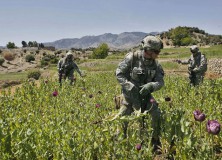The Counternarcotics Effort in Afghanistan — Matthew Korade

INTRODUCTION:
With roots that predate the Soviet-Afghan War, Afghanistan’s opium trade has exploded into a multi-billion-dollar industry that encircles the globe. In 2007, Afghanistan produced about 90 percent of the world’s opium supply and the country has driven the doubling of global production since 2005. The drug trade has fueled corruption, allegedly reaching into President Hamid Karzai’s family, and has become the primary funding mechanism for the Taliban insurgency. After a slow start, the United States is putting increased effort into counternarcotics. However, a flawed strategy, weak staffing, and a series of interagency problems have hindered progress. The failure to combat the opium trade has directly contributed to the continuing instability and insurgency within Afghanistan.
STRATEGY:
At the highest levels, the Office of National Drug Control Policy sets counternarcotics policy, and the National Security Council coordinates Afghanistan issues. Early on, the Bush administration opposed enlarging the U.S. military’s security mission to include drug interdiction and eradication. The administration feared this approach might interfere with the pursuit of high-value targets in Operation Enduring Freedom and the White House was also averse to bogging down the military with what it viewed as a nation-building task. As criticisms of counternarcotics policies mounted, the White House unveiled a new counterdrug strategy at the end of 2004. The policy complemented Afghan and British counternarcotics programs and included five main pegs: eradication, interdiction, alternative livelihoods, police/judicial reforms, and public awareness. The plan called for simultaneous, sequential, and balanced actions to root out corruption and improve security while establishing the rule of law.
INTEGRATED ELEMENTS OF NATIONAL POWER:
The State Department’s Bureau of International Narcotics and Law-Enforcement Affairs coordinates the U.S. government’s Afghanistan counternarcotics efforts. The State Department also directs eradication, the largest and most visible program in the Afghan drug war, and the communications campaign. The U.S. Agency for International Development is the lead agency on alternative-livelihood programs, which experts believe are critical to filling the economic void left by eradication. The Department of Justice’s (DOJ) Drug Enforcement Agency (DEA) manages interdiction and DOJ is also the lead agency for law-enforcement and judicial reforms in Afghanistan. DEA units have received intelligence and logistical support from the Defense Department since 2005, although the military has not deliberately targeted drug labs or warehouses unless soldiers ran across them on routine operations.
EVALUATION:
The overall response to Afghanistan’s opium problem was weak from the start, in part because U.S. and world leaders initially failed to recognize the truly destabilizing effect of Afghanistan’s drug trade. Early U.S. analysis of the problem was muddled; officials blamed opium for Afghanistan’s security problems while paradoxically claiming that insecurity was the main obstacle to an effective counternarcotics strategy. The failure to recognize the criticality of state-building to counternarcotics operations has resulted in counterproductive actions, poor planning and coordination, and tensions between counternarcotics and counterterrorism. In addition, much of the U.S. funding for counternarcotics is not included in agencies’ annual budgets. Rather, it is provided through supplemental, or “emergency” spending bills, which make it difficult for Congress to perform its important oversight function. The counternarcotics mission has also been hindered by a uniform shortage of personnel across involved agencies and departments. A simultaneous reliance on contractors has led to management and communication problems, as many contractors were barred from supervising other contractors or government employees. The contracts themselves were drafted quickly, with minimal input from the U.S. embassy in Kabul.
RESULTS:
The United States has spent about $1.6 billion on counternarcotics to date but with little effect. The Taliban and al Qaeda continue to benefit from the drug trade directly through trafficking and cultivation and indirectly by providing protection, taxing production, or engaging in money laundering. Experts estimate the drug trade provides up to half the Taliban’s funding and somewhat less for al Qaeda. In addition, the heavy focus on eradication has alienated small farmers and left other elements of the U.S. strategy neglected. The opium trade has resulted in corruption and security problems that have proved toxic to the Afghan government. Afghanistan was the eighth most-unstable nation in the world in 2007, according to the “Failed State Index” compiled annually by the U.N. Fund for Peace and Foreign Policy magazine.
CONCLUSION:
There is clear evidence that the drug trade finances the Taliban and a strong correlation exists between cultivation and attacks on coalition forces. If Afghanistan’s opium trade were destroyed, it would deal a serious blow to the insurgency and free the government from a corrupting influence. This victory, experts agree, cannot be achieved without a prolonged plan for economic development. It also cannot be accomplished without a rapid build-up in the Afghan government’s capacity to enforce security and the rule of law. Thus, the approach will require that the United States use “soft” and “hard” power in a comprehensive, cohesive manner.